As businesses grow, the need for marketing automation becomes more apparent. Manually managing the increasing tasks related to customer engagement is no longer sustainable.
A well-crafted marketing automation strategy can help optimize workflows and enhance scalability. It allows you to manage larger audiences efficiently and make data-driven decisions.
The effectiveness of automating marketing activities isn’t in doubt. According to Adobe, 98% of marketers say marketing automation is crucial to their success.
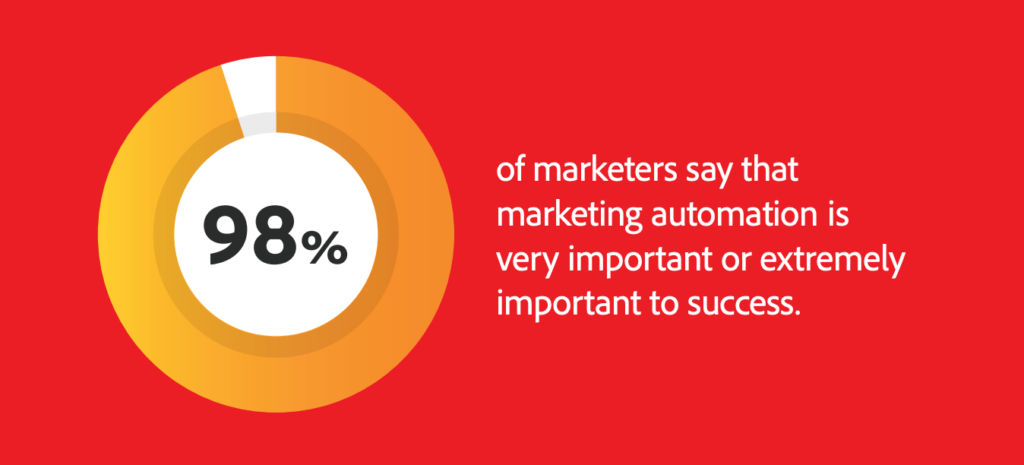
Source: the state of marketing automation, Adobe, 2023
We’ve created this comprehensive guide to teach you how to create a solid marketing automation strategy. It can help you streamline your processes, enhance customer engagement, and boost your business. We’ll also examine the top email marketing automation platforms for your consideration.
What is a marketing automation strategy?
A marketing automation strategy is a blueprint for optimizing and streamlining personalized marketing communication. It outlines how to automate key marketing messages using software solutions.
A marketing automation strategy allows you to deliver consistent experiences throughout the buyer’s journey. It improves marketing efficiency and drives predictable results through your outreach initiatives.
When crafting an effective email marketing automation, it’s essential to consider the following factors:
- Your target audience: Provide comprehensive details about your target users and pre-defined segments.
- The content to automate: Highlight the content and workflows you’ll automate. This will help you connect with your audience at different stages of the buyer’s journey.
- Automation timeline: Recommend a timeline for your automation campaigns to ensure timely engagement.
- Evaluation plan: Highlight the metrics you’ll track and analyze. It will help you gauge the effectiveness of your automated marketing campaigns.
- Compliance and data security: Highlight measures to safeguard customer data. Complying with privacy regulations is also essential.
- Training and skill development: Undergo training and skill development to upskill. Learn how to use automation tools to streamline your communication.
- Choose the right automation tool: Choose a marketing automation tool that meets your needs. These tools should also seamlessly integrate with your existing tech stack.
How marketing automation can help your team achieve goals
Marketing automation plays a vital role in enhancing operational efficiency. According to Insightly, 94% of marketers say automation has helped them achieve their strategic goals.
Source:
Let’s examine the benefits of marketing automation platforms. We’ll also discuss how these tools can help you achieve your business goals.
- Marketing automation makes your team more efficient. It allows your members to allocate their time to more strategic tasks, such as generating innovative campaign ideas.
For instance, you can automate the process of sending welcome emails to subscribers. Automating the process gives you more time for creative tasks. You can explore innovative marketing approaches. - Marketing automation tools can help you learn more about your audience. These tools track how potential customers interact with your website. With marketing automation tools, you’ll have a more prosperous and precise understanding of your customer’s onsite and email behavior.
- With a well-thought-out marketing automation strategy, you won’t miss your chance to earn revenue. Customers who abandon your website or their shopping carts, lapse purchasers, and VIP customers—they all can become buyers if the right message is sent at the right time. Not implementing marketing automation means leaving money on the table.
- Marketing automation empowers personalized customer journeys. Research shows that customers want to feel like VIPs when interacting with brands.

Personalization encourages repeat purchases, and it helps convert leads into customers. Marketing automation tools collect relevant information about your leads. This allows you to deliver highly-targeted content to your leads and convert them into repeat customers.
- One of the key benefits of marketing automation is its ability to collect customer data. It also uses the data to summarize your marketing efforts comprehensively. With this data, you can make better decisions that enhance business growth. For instance, marketing automation helps you know:
- Which content assets to prioritize
- When to engage your audience
- Which incentives drive more conversions
- Where leads drop off in the nurturing process
These insights will help you make smarter decisions to optimize your marketing automation strategy.
Email drip campaign vs email automation campaign: What’s the difference?
This post focuses on setting up an email marketing automation strategy. However, we need to clarify that there are distinctions between email drip and automation campaigns.
More often than not, people confuse drip and automation campaigns. It’s important to note that they aren’t the same thing.
In this section, we’ll discuss the differences between an email drip campaign vs email automation campaign.
Drip campaigns are static
Drip campaigns are automated email campaigns. They reach subscribers regardless of their behavior. Subscribers automatically receive these email campaigns at a set time interval. By organizing these emails into a sequence, or “drip,” brands maintain consistency in communication. Brands often use drip campaigns for user onboarding and educational campaigns.
Suitable examples of drip campaigns include:
- A welcome series that delivers a set number of emails to new subscribers
- A promotional email campaign that sends discounts to subscribers on specific occasions
It is clear from the definition and examples above that drip campaigns are automated. So, what makes them different from email automation campaigns?
Let’s find out below.
Email automation is dynamic
Email automation campaigns differ from drip campaigns because of their dynamic nature. Businesses deliver these campaigns based on users’ actions. For instance, a customer buys a product and doesn’t revisit the store within a specified timeframe.
In this case, you can send an automated personalized re-engagement email to invite them back to the store.
You can also see the dynamic nature of email automation campaigns in their content. Drip campaigns deliver the same message across the board. On the other hand, email automation campaigns are personalized for individual users and may vary according to their behavior.
For instance, two customers both forgot an item in their shopping cart. These two will not receive the same automated cart abandonment notification. Each email will include the specific items left behind in the shopping cart. This creates a personalized shopping experience for each user.
Other examples of email automation campaigns include:
- Upsell email campaigns that recommend more expensive products to increase customer spend
- Cross-sell email campaigns with complementary products
- Anniversary emails that send special discounts to customers after one year
Four steps to create a successful marketing automation strategy
Follow these steps to develop a strategy to automate marketing tasks and workflows.
Step 1: Define your goals
Start by setting clear and measurable goals for your marketing automation. Ensure the goals you set align with your overall business objectives.
Do you want to:
- Generate more leads?
- Convert more customers?
- Improve customer retention?
- Recover more carts?
Be as specific as possible when setting your goals. This is because these set goals will help you determine what to automate.
For example, your strategy should prioritize automated email follow-ups to increase cart recovery. The follow-up message will include the items left in the cart. This encourages shoppers to complete the purchase.
What’s more, being specific allows you to assess the effectiveness of your strategy. For example, to convert 500 subscribers into customers with a welcome series.
At the end of the month, confirm if you have met this goal. If you didn’t, optimize your strategy to achieve this goal.
Step 2: Name the measurements of the marketing automation performance
With your goals set, it’s time to define the metrics you’ll use to measure progress.
Referring to our earlier goals, the common benchmarks include:
- Lead generation: Click-through rate (CTR), number of new subscribers and customers from subscribers.
- Customer conversion: Customer acquisition cost (CAC), average revenue per customer (ARPC), and customer lifetime value (LTV).
- Customer retention: Customer retention rate, repurchase rate, growth rate.
- Cart recovery: Cart recovery email open rate, time to recovery, recovery rate.
- Sales.
These metrics indicate the effectiveness of your marketing automation strategy. If you’re not meeting your set targets, take the necessary measures to optimize your tactics.
Step 3: Find the right marketing automation platform
The next step is to identify the right tool to achieve your goals. With so many options to choose from, finding the right tool might be a daunting task. However, examining your needs and budget helps you identify a tool that aligns with your goals.
Use the following questions as a guide when choosing marketing automation software:
How advanced should the platform be?
The automation you want to create will determine the right tool for you. A basic platform will suffice if you’re only looking to set up simple automation.
However, you need a robust tool with advanced features for more advanced automation.
It’s important to consider the features and capabilities when choosing a tool. This is because a tool’s features determine its price. Luckily, modern automation tools are scalable and have tiered pricing plans. This allows you to pay for the features you need and upgrade as your needs increase.
Can I combine a new platform with my existing tech stack?
Choose a marketing automation tool that integrates seamlessly with your existing tech stack. This streamlines your workflows and provides a holistic look at your customer interactions.
It also allows for better decision-making, thereby improving your overall business processes.
What marketing channels am I going to automate?
As an ecommerce business, you can choose multiple channels that align with customer touchpoints. However, email remains a primary and essential marketing channel. With email, you can create various automated campaigns for different ecommerce purposes.
You can further combine email with SMS and push notifications. This makes for a truly omnichannel marketing experience. This approach gives you more customer touchpoints. It also increases your visibility and drives conversions from multiple channels.
Step 4: Implementation and review
Establish your marketing automation strategy and implement it using your chosen automation software. Set up your automated workflows, and monitor and track performance issues.
It’s important to note that setting up might be difficult for beginners. So, use all the helpful resources at your disposal to learn how to automate different campaigns. Also, implement strategies to restore the process if it malfunctions.
The most common marketing automation workflows in ecommerce
The information shared above should enable you to implement marketing for your business. Before we continue, let’s discuss a few marketing automation workflows for your inspiration.
Welcome series
The welcome series is one of the foundational processes to consider. This series involves sending a sequence of automated emails to new subscribers.
The emails warmly introduce your brand, encouraging initial engagement.
Welcome messages are also effective compared to other automated campaigns. According to Omnisend, welcome emails have a conversion rate of 2.74%. They also have the best click-to-conversion rate of 55.9%.

Source: Email, SMS, and push marketing statistics for ecommerce in 2024, Omnisend
As for the message to include in your welcome messages, consider the following ideas:
- Thank the subscriber for subscribing to your email list
- Share your brand story and values
- Showcase your products
- Offer exclusive discounts or promotions
- Share top reviews from past customers
Consider the following welcome email from Bark & Bitter. The company thanks the user for joining its email list. It then gives the user a special discount for their first purchase. The email also highlights the top products.

Image via Really Good Emails
Browse abandonment
Sometimes, visitors browse your online store and leave without placing an order. In this case, you can create an automated workflow to get the visitor back on your site.
It’s particularly useful when people visit your site pages and leave without buying. You can also use it for visitors in your email list.
You can customize the email content by doing the following:
- Reminding them of the products they viewed
- Showcasing related products
- Offering exclusive discounts and incentives
- Creating a sense of urgency with time-limited offers
- Sharing the top reviews of the products they viewed
Rael has a browse abandonment workflow. In the example below, it showcases the product the visitor viewed. It also offers free shipping to bring visitors back to the store to complete the action.

Image via Really Good Emails
Cart abandonment
Shoppers often add products to the cart but don’t complete the purchase. Rather than letting such customers leave, target them with a cart recovery email. This will help you return them to the store to finish the purchase.
Tracking how many customers leave without completing a purchase can be tedious. However, marketing automation helps you know when someone abandons a cart. It adds the user to a workflow that reminds them of the products they’ve left behind.
Cart abandonment emails have also been found to be very effective. According to Omnisend, the conversion rate for abandoned cart emails is 2.56%.
You can customize your email content in the following ways:
- Include items left in the cart
- Offer special discounts to encourage completion
- Share the top reviews of the products added to the cart
Mack Weldon uses marketing automation to recover abandoned carts. In the example below, Mack Weldon reminds the customer of the items they’ve left behind. It also uses FOMO to encourage the shopper to complete the purchase.
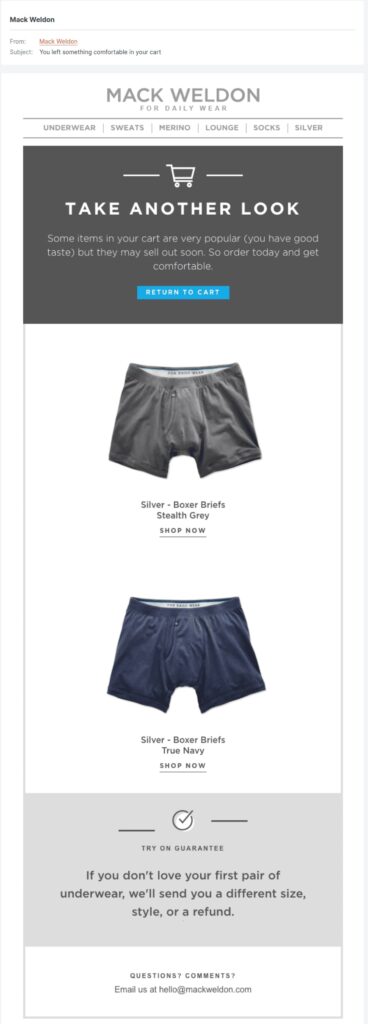
Image via Really Good Emails
Post-purchase series
The post-purchase series is commonly used to thank customers who have completed orders. It’s also used to recommend other products that the customer may enjoy. These can be complementary products or upsells that offer more value.
In the example below, Urth thanks the customer for their order. They also recommend other products that align with the customer’s purchase.

Image via Really Good Emails
Lapsed purchase series
Securing an initial purchase from a customer is indeed noteworthy. However, fostering repeat purchases surpasses this achievement.
That’s why tracking your customer’s orders is important. Tracking customer’s orders lets you know whether they’re making repeat purchases. Alternatively, you can establish a lapsed purchaser workflow to encourage these users to repurchase.
These include a series of emails strategically crafted to entice the shopper to return to your store. For a start, establish the specific time frame when a user is considered a lapsed purchaser.
From here, you can customize your emails in the following ways:
- Express your appreciation for their last order
- Make relevant recommendations based on their last order
- Offer personalized discounts
The best email marketing automation tools for ecommerce
Choosing the right software is important. It determines the successful implementation of your email marketing automation strategy. Consider the following when choosing an automation platform:
- Features
- Pricing
- Integrations
- Scalability
The popular email marketing automation platforms worth considering include:
Omnisend

Image via Omnisend
Omnisend is a leading marketing automation software solution. It offers email marketing services as well as SMS marketing and push notifications. The platform ensures you have an omnichannel marketing experience.
The platform has all the tools you need to streamline your marketing efforts. Compared to other platforms, Omnisend is very affordable. It delivers robust features and functionalities at a cost-effective price point.
Its extensive free plan allows you to explore its features without making any financial commitment. Omnisend’s award-winning customer support also provides the right guidance to optimize campaigns.
It also has a user-friendly campaign builder and ready-to-use automation workflow templates. These features make it a great choice for ecommerce marketers of all sizes.
Klaviyo
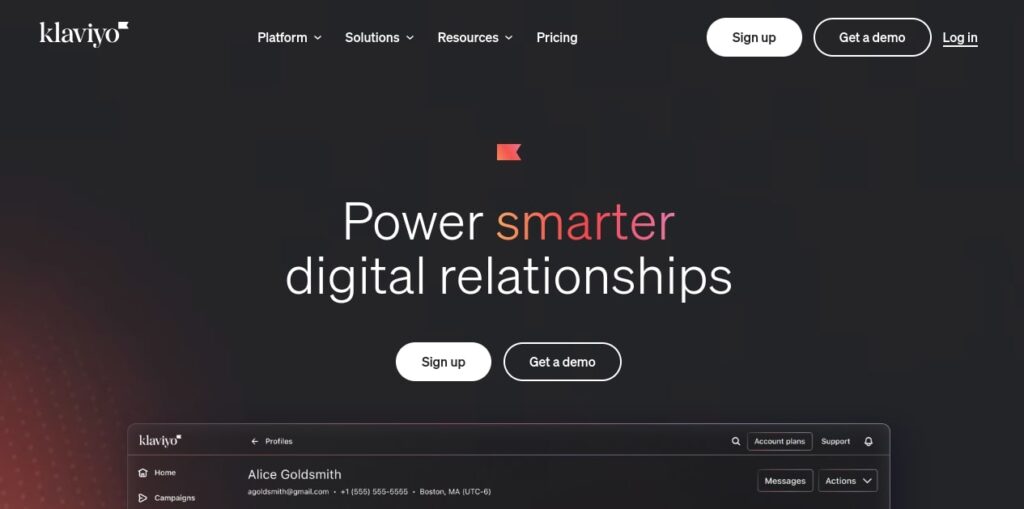
Image via Klaviyo
Klaviyo is a reliable marketing automation platform. It comes with pre-designed email templates and workflows. These will help you create email campaigns with ease. The platform captures comprehensive customer data to help you deliver personalized campaigns.
Klaviyo supports email marketing automation and SMS automation. This provides more opportunities to engage with your potential customers and convert them into repeat customers.
Klaviyo’s key features include the following:
- Rich library of email templates
- Mobile-friendly web forms to help you grow your email list
- Seamless integration with your tech stack
- Many segmentation options
- Easy-to-use campaign builder
Mailchimp
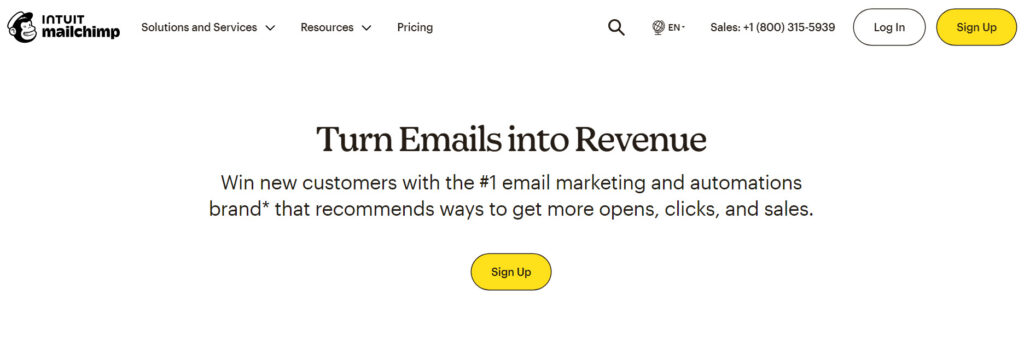
Image via Mailchimp
Mailchimp is one of the oldest marketing automation platforms out there. This innovative platform automates your tasks to help you turn emails into revenue.
The seamless automation builder and pre-built journeys will help you automate different tasks. To gauge the effectiveness of your campaigns, Mailchimp provides custom reports. Insights from the reports will help you optimize your automation strategy effectively.
Mailchimp’s key features include:
- Reliable personalization capabilities
- Built-in AI tools to help you create engaging content
- Predictive segmentation
- Enhanced automation workflows
- Seamless campaign manager
Sendlane
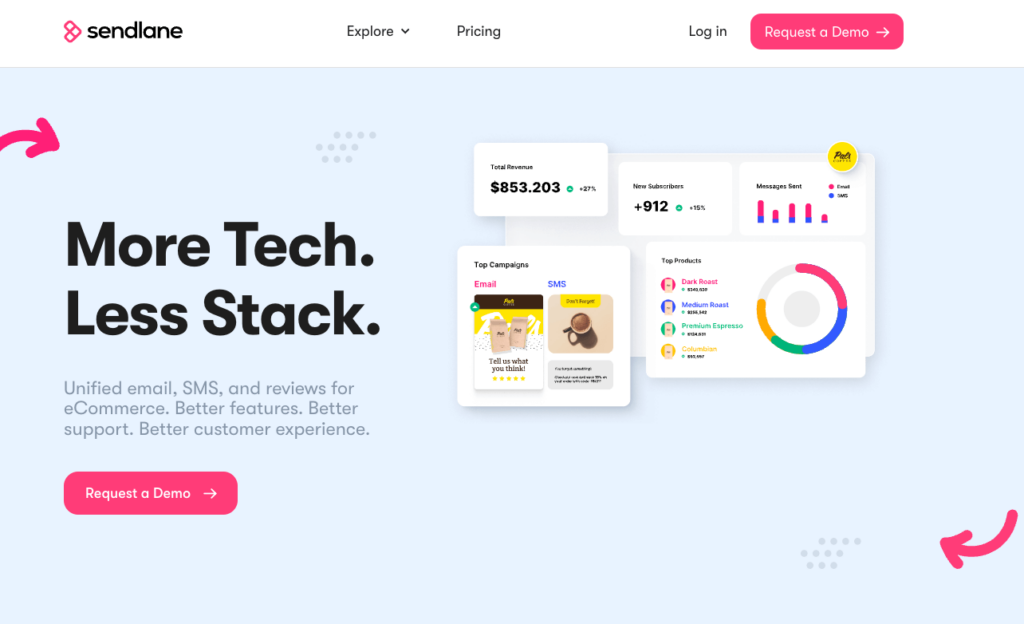
Image via Sendlane
Sendlane combines email and SMS marketing. This will help you create omnichannel experiences for your audience. To simplify campaign management, Sendland comes with pre-built funnel templates.
Sendlane’s real-time insights provide valuable information to improve your campaigns. It also combines seamlessly with other tools in your tech stack to help you do more with email marketing.
Sendlane’s key features include:
- Deep data integrations
- Multiple channels automation
- Data-driven audience segmentation
- Fully integrated review collection and management
- Easy popup forms to grow your email and SMS list
Moosend
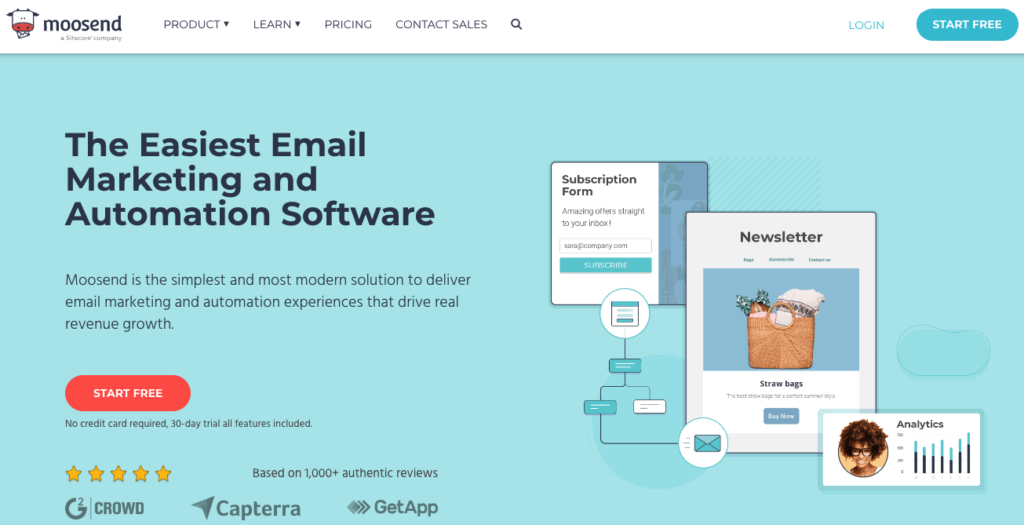
Image via Moosend
With excellent features for building campaigns, Moosend is one of the most affordable marketing automation tools. It also comes with pre-built automation workflows.
Compared to other tools, Moosend is more affordable. However, it doesn’t have native integration with Shopify. This minor detail could limit its suitability for businesses using Shopify.
Moosend’s key features include:
- Ready-to-go automation workflow templates
- Pre-built landing pages and forms to grow your email list
- Robust list segmentation
- Detailed campaign reports
- Leverages AI to improve your writing
Marketing automation strategy: Wrap up
Setting up a marketing automation strategy has numerous benefits for your business. It can help increase your operational efficiency and deliver personalized content at scale. It can also generate and nurture leads and so much more.
We’ve discussed popular automation workflows and proven expert strategies above. Try implementing them to yield positive results.
